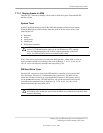
Technical Reference Guide
7.7.3.1 Staying Awake in APM
There are two "Time-out to Standby" timers used in APM: the System Timer and the IDE
had Drive Timer.
System Timer
In POST, the ROM enables a timer in the ICH2 that generates an SMI once per minute.
When the ROM gets the SMI it checks status bits in the ICH2 for activity at any of the
following devices:
♦ Keyboard
♦ Mouse
♦ Serial port(s)
♦ Parallel port
♦ IDE primary controller
NOTE: The secondary controller is NOT included in order to support auto-
sense of a CD-ROM insertion (auto-run) in case Windows or NT is running.
Note also that management of SCSI drives is the responsibility of the SCSI
driver. Any IDE hard drive access resets the hard drive timer.
If any of the activity status bits are set when the ROM gets the 1-minute SMI, it resets its
time-out minute countdown according to the value (0 (default), 5, 10, 15, 20, 30, 40, 50,
60, 120, 180, or 240 minutes) selected in the Setup utility (F10).
IDE Hard Drive Timer
During POST, an inactivity timer in the IDE hard drive controller is set to control hard
drive spin down. This activity is independent of the system timer. The BIOS will not
inform the O/S that it is time to go to sleep until there has been no IDE primary activity
for the system time-out time. The IDE hard drive will spin down when its timer expires
according to the countdown time (0 (disabled), 10, 15, 20, 30, 60, 120, 180, or 240
minutes) selected in the Setup utility (F10).
NOTE: The O/S (Win98 and later) can use the "Enable/Disable Timer Based Request"
APM BIOS call to disable the system timer the BIOS uses so that the O/S can have direct
control of the timing.
Compaq Evo and Workstation Personal Computers
Featuring the Intel Pentium 4 Processor
Second Edition - January 2003
7-21


















